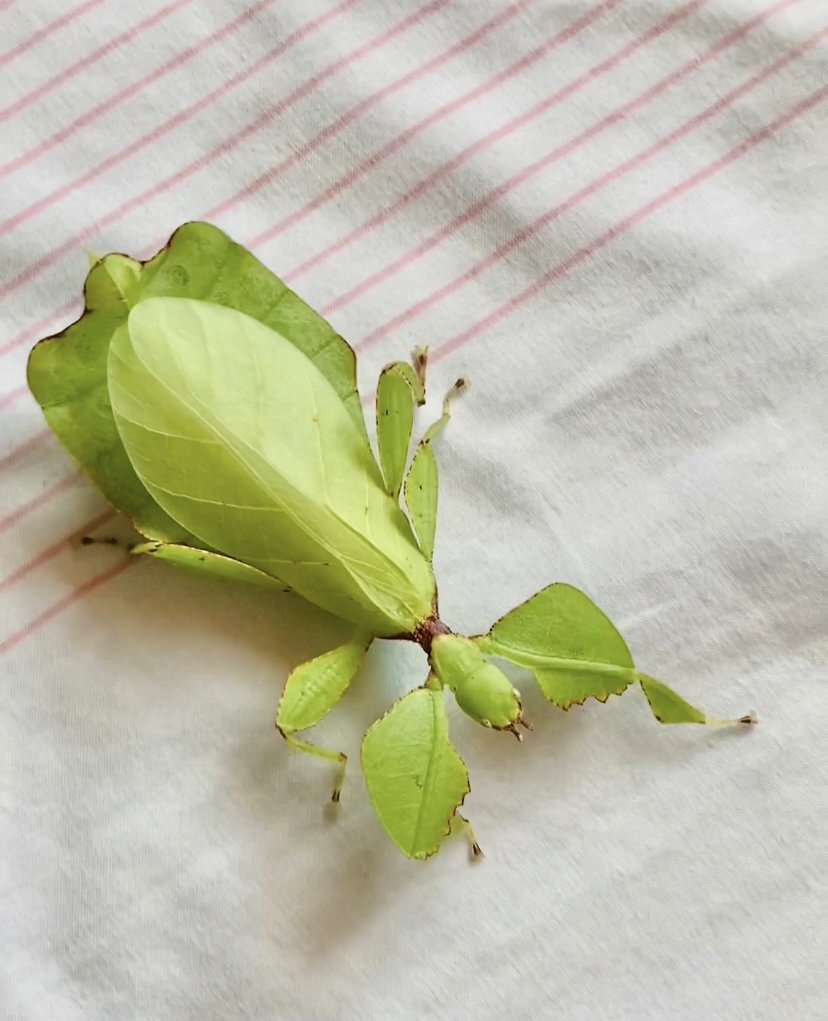Breedsheet: Leaf Insects | คู่มือเพาะเลี้ยงและการอนุบาลตั๊กแตนใบไม้
Hello, everyone. This part is about how to breed leaf insects, and how to care for the nymphs. In this post, I wrote about my records of breeding and caring Cryptophyllium westwoodii from L1 – L4. After your nymphs turn to L4 already. You can use the method of caring from “Caresheet: Leaf Insects | คู่มือดูแล: ตั๊กแตนใบไม้” to be your guide.
สวัสดีครับ ทุกคน ในส่วนนี้จะเป็นเนื้อหาเกี่ยวกับการเพาะพันธุ์และการดูแลตัวอ่อนของตั๊กแตนใบไม้ ซึ่งในโพสต์นี้ ผมเขียนเล่าเรื่องราวผลการบันทึกและสังเกตุการณ์การเพาะพันธุ์และดูแล ตั๊กแตนใบไม้เล็กลำพูน (Cryptophyllium westwoodii) จาก L1 ถึง L4 หลังจากที่เด็กเข้าสู่ระยะ L4 แล้ว คุณสามารถใช้วิธีการดูแลจาก “Caresheet: Leaf Insects | คู่มือดูแล: ตั๊กแตนใบไม้” เป็นไกด์ได้
How to Breed Leaf Insects | วิธีการเพาะพันธุ์ตั๊กแตนใบไม้
There are two ways to breed leaf insects in captive breeding. Naturally, leaf insects are able to lay their eggs without fertilization. It is very interesting to breed when you know your leaf insects do not necessarily let them mate with each other. For example, Phyllium giganteum is able to lay unfertilized eggs, which are able to hatch. But all of hatching the unfertilized eggs become female for 100%. And it will take a long time to hatch than fertilized eggs. Anyways, I explain two methods for breeding leaf insects.
มีการเพาะพันธุ์ตั๊กแตนใบไม้อยู่ 2 วิธีในการเพาะเลี้ยงแบบจำกัดพื้นที่ โดยธรรมชาตินั่นตั๊กแตนใบไม้สามารถวางไข่โดยไม่ผ่านการปฏิสนธิได้ ซึ่งมันเป็นสิ่งที่น่าสนใจมากในการเพาะพันธุ์ เมื่อคุณรู้ว่าตั๊กแตนใบไม้ของคุณนั้นไม่จำเป็นต้องผ่านการผสมพันธุ์ก็ได้ ยกตัวอย่าง เช่น ตั๊กแตนใบไม้ยักษ์มาเลเซีย (Phyllium giganteum) สามารถวางไข่ที่ไม่ผ่านการปฏิสนธิได้ และยังสามารถฟักได้อีกด้วย แต่ไข่ที่ฟักทั้งหมดจะเป็นเพศเมีย 100% และใช้ระยะเวลาในการฟักนานกว่าไข่ที่ผ่านการปฏิสนธิแล้ว อย่างไรก็ตาม ผมจะอธิบายทั้งสองวิธีสำหรับการเพาะตั๊กแตนใบไม้
Unfertilized Breeding | การเพาะแบบไม่ผสม
After the female becomes an imago. We have to let the female inside an insect cage. Don’t forget to provide food plants. It takes several weeks to lay the eggs. The unfertilized eggs approximately take 6 – 8 months to hatch. Generally, the female lays the egg(s) around 1 – 3 egg(s) per day. I usually collect the eggs in an incubation box/cup immediately.
หลังจากตัวเมียกลายเป็นตัวเต็มวัยแล้ว เราต้องปล่อยตัวเมียภายในกรงเลี้ยง อย่าลืมให้พืชอาหาร ใช้เวลาหลายสัปดาห์กว่าที่ตัวเมียจะเริ่มวางไข่ ไข่ที่ไม่ถูกปฏิสนธิใช้ระยะเวลาโดยประมาณ 6 – 8 เดือนในการฟัก โดยทั่วไปตัวเมียวางไข่ราว 1 ถึง 3 ฟองต่อวัน ผมมักเก็บไข่ทุกใบลงในกล่อง/ถ้วยเตรียมฟักไข่ทันทีอย่างสม่ำเสมอ
Fertilized Breeding | การเพาะแบบผสม
The leaf insect is easy to breed in captivity. I let the male and female inside an insect cage together. In fact, the female becomes an adult at the seventh instar (L7), but on the other hand, the male becomes an adult at the sixth instar (L6). It is early to be the imago for the male. Therefore, the female might take several days to be ready to mate the male.
After mating, the female takes a couple of days to start to lay the egg(s). And again, when we see the egg(s), don’t forget to collect the eggs in an incubation box/cup.
ตั๊กแตนใบไม้นั่นง่ายต่อการเพาะในพื้นที่จำกัด ผมปล่อยตัวผู้และตัวเมียในกรงเลี้ยงด้วยกัน ในความเป็นจริงแล้ว ตัวเมียจะกลายเป็นตัวเต็มวัยในระยะที่ 7 และซึ่งในทางกลับกัน ตัวผู้จะกลายเป็นตัวเต็มวัยในระยะที่ 6 ซึ่งเร็วมากในการกลายเป็นตัวเต็มวัยสำหรับตัวผู้ ดังนั้นตัวเมียอาจใช้เวลาหลายวันกว่าที่จะพร้อมผสมกับตัวผู้
หลังจากผสม ตัวเมียจะใช้ระยะเวลา 2 – 3 วันในการเริ่มวางไข่ และย้ำอีกครั้งว่า เมื่อเราเห็นไข่ อย่าลืมเก็บไข่ไว้ในกล่อง/ถ้วยเตรียมฟักไข่
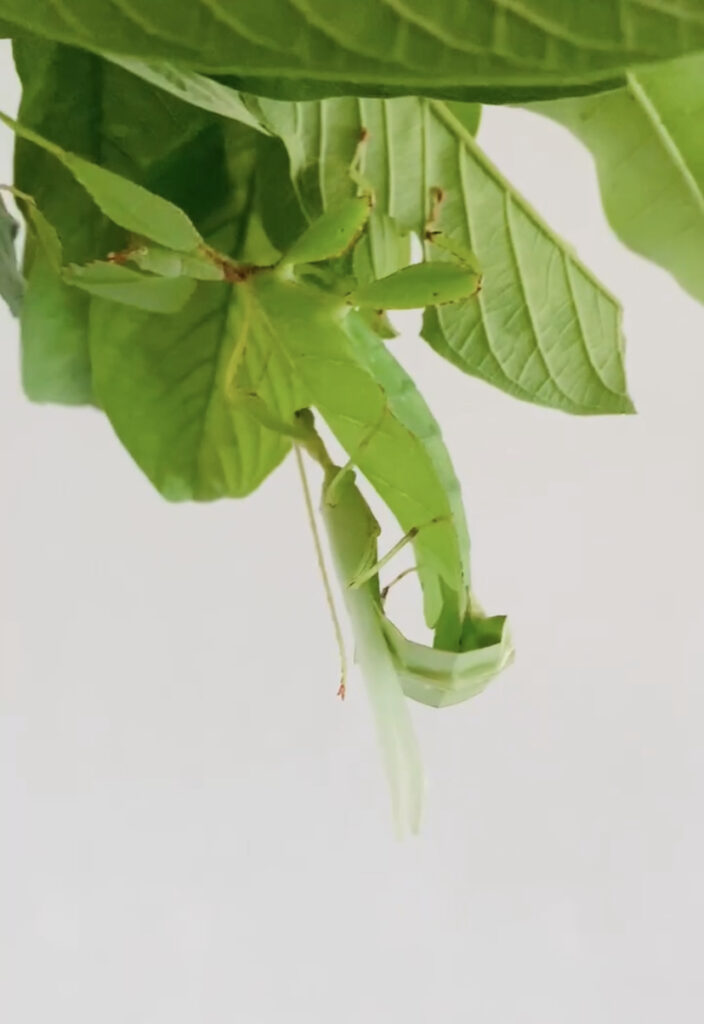
How the Leaf Egg Does Look Like? | หน้าตาไข่ตั๊กแตนใบไม้เป็นอย่างไร
In different species make different eggs look. It is very hard to find the eggs at first time for the new breeder. Sometimes, the eggs look like the wastes from our leaf insects. In this case, I provide only Cryptophyllium westwoodii‘s egg to you all. For another species, you are able to find them on the internet by searching the scientific name. Moreover, Cryptophyllium westwoodii provides the different colored eggs. And the color is on discussion whether the colored egg is able to determine which fertilized or unfertilized egg is.[1]
ในสายพันธุ์ที่แตกต่างกันทำให้หน้าตาของไข่ก็ต่างกันไป ซึ่งมันยากมากในการหาไข่ในครั้งแรกสำหรับมือใหม่ เพราะบางครั้งเอง ไข่ก็ดูคล้ายกับของเสียจากตั๊กแตนใบไม้ของพวกเรา ในกรณีนี้ ผมจะนำรูปภาพของไข่ตั๊กแตนใบไม้เล็กลำพูน (Cryptophyllium westwoodii) ให้กับพวกคุณทุกคน สำหรับสายพันธุ์ คุณสามารถหารูปได้บนอินเทอร์เน็ตโดยค้นหาด้วยชื่อวิทยาศาสตร์ อีกทั้งตั๊กแตนใบไม้เล็กลำพูนก็วางไข่ให้สีของไข่ที่แตกต่างกัน และสีนั่นยังอยู่ในการพิจารณาของนักวิจัยว่าสีไข่สามารถแยกไข่ที่ปฏิสนธิหรือไม่ปฏิสนธิได้[1]


How to Incubate the Eggs | วิธีการเตรียมฟักไข่
This method that I use for incubating the eggs is an adaptive method from the cup-incubation method[2]. And both methods work. There are three incubation methods for the leaf insects and Phasmatodea that you can learn and try on Phasmatodea.com
วิธีนี้ที่ผมใช้นั่นเป็นการปรับเปลี่ยนจากวิธีการฟักในถ้วย (the cup-incubation method)[2] และได้ผลทั้งคู่ ซึ่งมีอยู่สามวิธีในการเตรียมฟักไข่สำหรับตั๊กแตนใบไม้ และแมลงจำพวกตั๊กแตนใบไม้และตั๊กแตนกิ่งไม้ (Phasmatodea) ที่คุณสามารถเรียนรู้และลองได้บนเว็บ Phasmatodea.com
Equipment | อุปกรณ์
- Vermiculite | เวอร์มิคูลไลท์
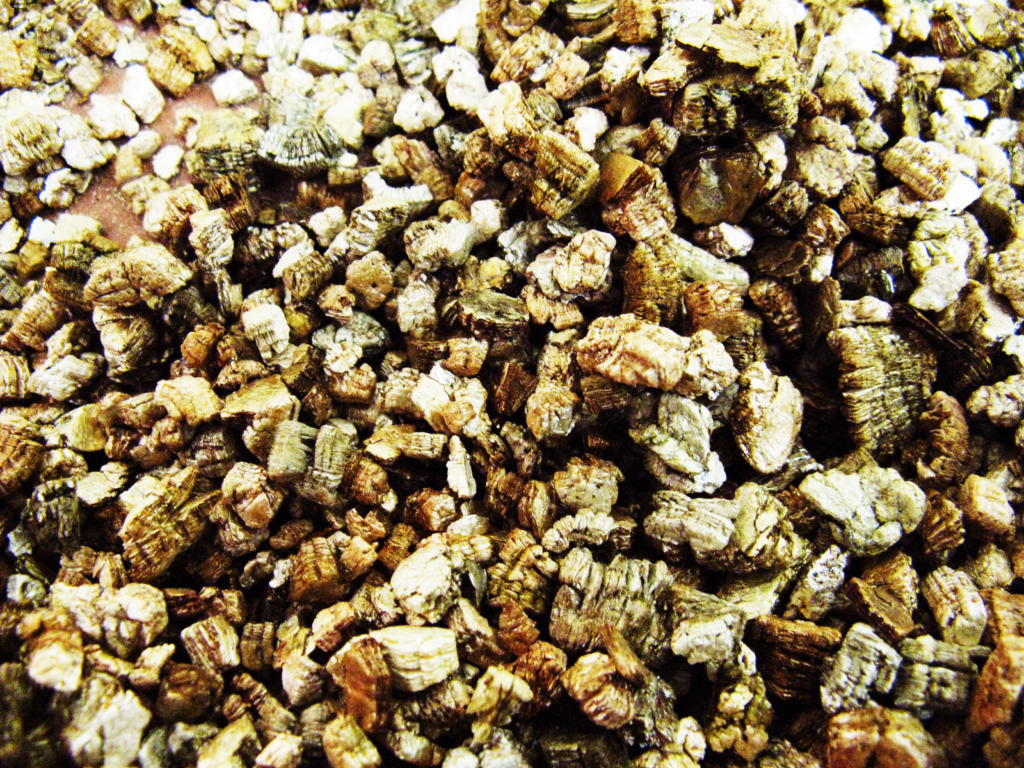
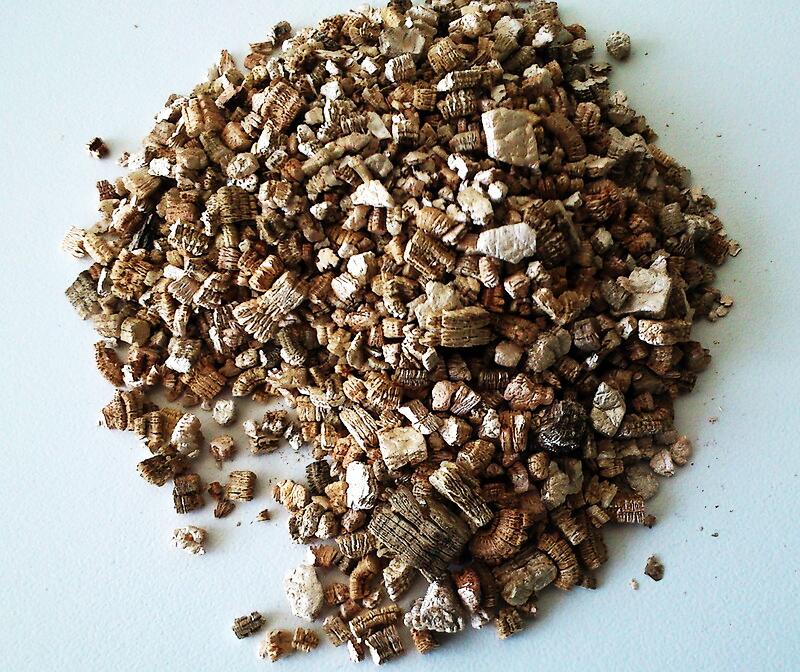
2. Plastic Box With Holes | กล่องพลาสติกพร้อมรูระบาย
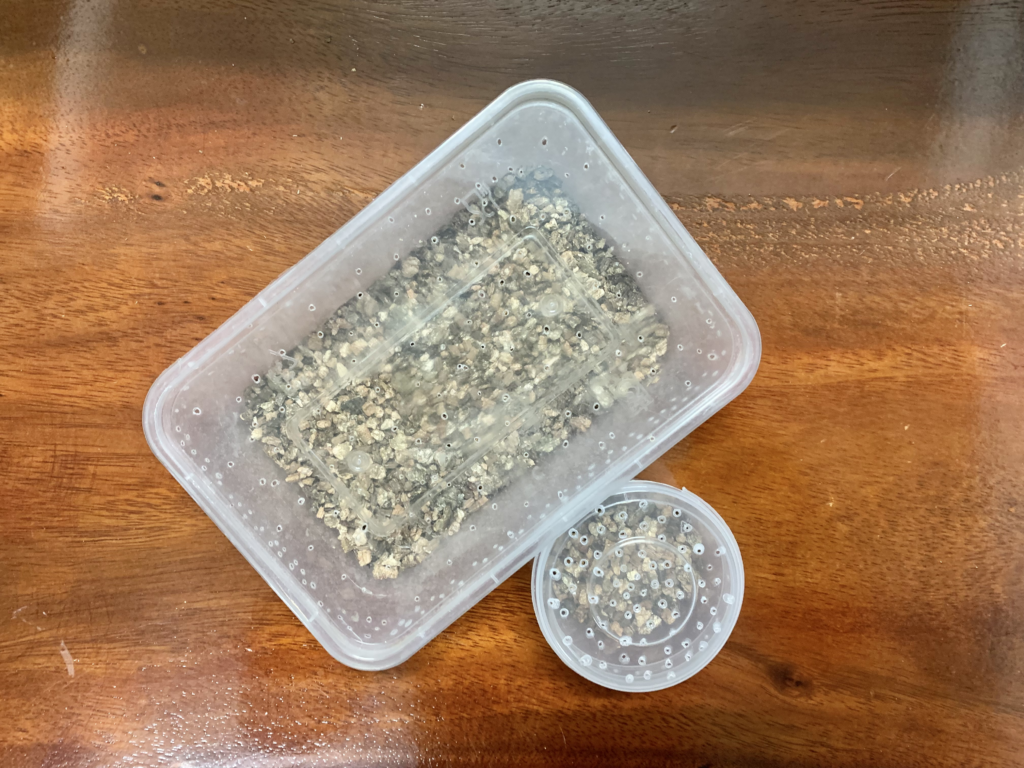
How To Incubate Leaf Insects’ Eggs | วิธีการฟักไข่ตั๊กแตนใบไม้
When we get the eggs, we have to make them hatch by incubation. So, we have to prepare the equipment for making the incubation box/cup.
- Drill the holes around a plastic box/cup and a cap.
- Put 1/4 of vermiculite in a plastic box/cup.
- Then spray the water inside a box/cup or put the water in a box/cup (Don’t be wet).
- Put the eggs in an incubation box/cup
เมื่อเราได้ไข่มาแล้ว เราต้องทำให้มันฟักออกมาโดยวิธีการควบคุมที่ฟักไข่ (incubation) ซึ่งเราต้องเตรียมอุปกรณ์สำหรับการสร้างกล่อง/ถ้วยสำหรับฟักไข่
- เจาะรูบริเวณรอบกล่อง/ถ้วยพลาสติก และบนฝาภานชนะ
- ใส่เวอร์นิคลูไลท์ลงไปในกล่อง/ถ้วยพลาสติก
- หลังจากนั่นสเปรย์พรหมน้ำข้างในกล่อง/ถ้วยพลาสติก หรือ ใส่น้ำในกล่อง/ถ้วย (ระวังอย่าให้เปียกจนเกินไป)
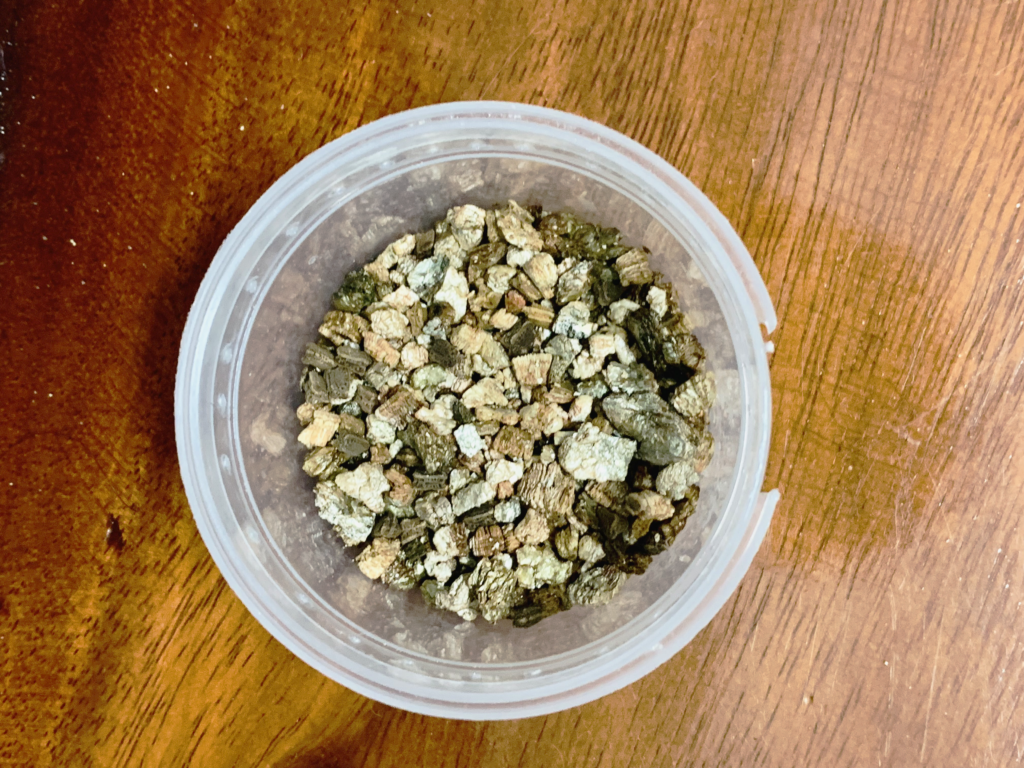
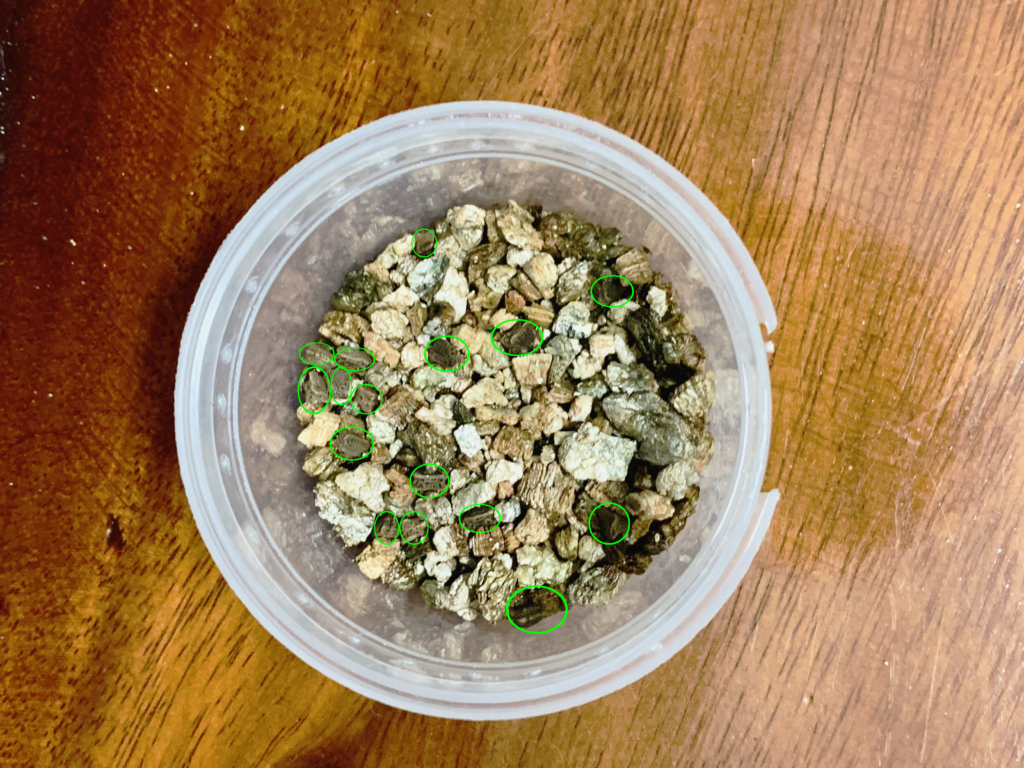
How to make them hatch | วิธีการดูแลให้ไข่ฟัก
Generally, fertilized eggs take around 3 – 5 months approximately to hatch in every species of leaf insect. Please keep the incubation box/cup at a temperature between 25 – 28 °C. In case, I have incubated the eggs of Cryptophyllium westwoodii at a warm temperature around 28 – 32 °C.
Can I incubate in the room with an air conditioner?
In my opinion, it is not a good idea. Because the leaf insect eggs need more humidity to hatch. The room with an air conditioner is less humidity for hatching. In the worst case, the eggs are able to hatch but the leg of the nymph is stuck in an egg. It is not able to get rid of the egg. And then it tries to get rip off the egg until it dies. Therefore, we should avoid less humidity by placing the incubation box/cup in the room well-ventilated.
โดยทั่วไป ไข่ตั๊กแตนใบไม้ที่ถูกผสมใช้ระยะเวลาในการฟัก 3 – 5 เดือน โดยประมาณ โปรดเก็บกล่อง/ถ้วยฟักไว้ในอุณหภูมิระหว่าง 25 – 28 °C ในกรณี ผมฟักไข่ของตั๊กแตนใบไม้เล็กลำพูน ผมฟักในอุณหภูมิประมาณ 28 – 32 °C
ฉันสามารถฟักไข่ในห้องแอร์ได้ไหม?
ในความคิดเห็นส่วนตัว มันไม่ใช่ความคิดที่ดีเท่าไร เพราะว่าไข่ของตั๊กแตนใบไม้ต้องการความชื้นในการฟัก ห้องแอร์นั่นมีความชื้นค่อนข้างต่ำสำหรับการฟัก ในกรณีที่เลวร้ายเลย ไข่นั่นสามารถฟักได้ แต่ขาของตัวตั๊กแตนใบไม้จะติดอยู่ในไข่ และหลังจากนั้นตัวอ่อนจะพยายามออกจากไข่อย่างสุดกำลังจนหมดแรง และตายไปในที่สุด ดังนั้น เราควรหลีกเลี่ยงความชื้นต่ำโดยการวางกล่อง/ถ้วยไว้ที่มีอากาศถ่ายเทดี
How to Care the First Nymph | วิธีการดูแลตัวอ่อนตัวแรก
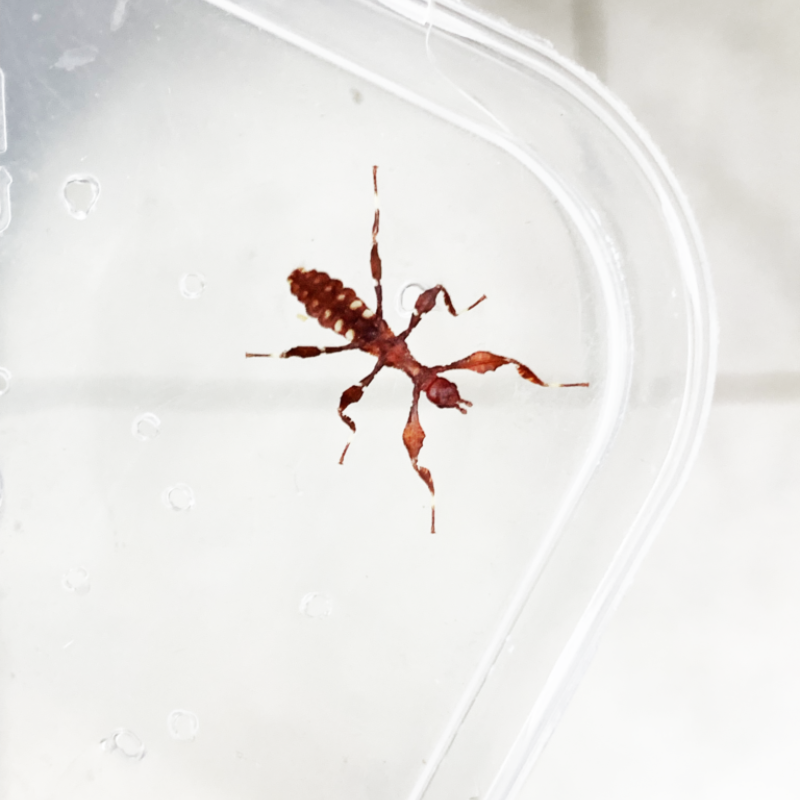
It is very exciting when we see the first leaf insect egg hatched. Generally, the nymphs will eat the leaves within 1 – 3 days after hatching. When I see the red nymph(s) in my incubation box/cup. I will move to leaves at once.
Food for the first instar (L1) I will take the light leaves to feed because the leaves are not too thick and it is easy to nibble. In case, you can’t find the light leaves. You can feed them with the green leaves instead. But the light leaves are perfect.
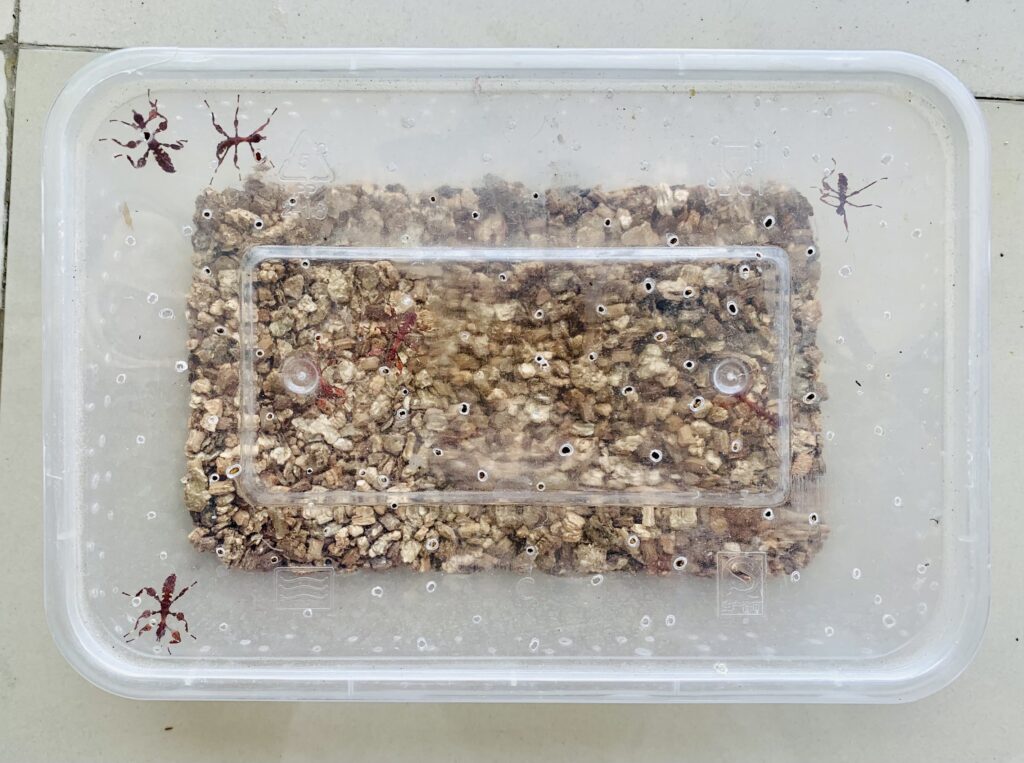
เป็นเรื่องน่าตื้นเต้นมากเมื่อเราเห็นตัวอ่อนตัวแรกฟักออกจากไข่เรียบร้อยแล้ว โดยทั่วไปตัวอ่อนจะกินใบไม้ภายใน 1 – 3 วัน หลังจากฟักออก เมื่อผมเห็นตัวอ่อนสีแดงในกล่อง/ถ้วยฟักไข้ ผมจะย้ายไปที่ใบทันที
อาหารสำหรับตัวอ่อนระยะหนึ่ง (L1) ผมจะเอาใบสีอ่อนป้อนให้กิน เพราะเนื่องจากใบไม่หนามาก และง่ายต่อการกัดแทะ ในกรณีที่คุณไม่สามารถหาใบอ่อนได้ เราสามารถป้อนพวกมันด้วยใบเขียวแทนได้ แต่ใบอ่อนนั่นดีที่สุด
Determine the Proper Foods for Our Nymphs | จำแนกอาหารที่เหมาะสมสำหรับลูกตั๊กแตนใบไม้
Light Mango Leaves (ใบมะม่วงอ่อน)
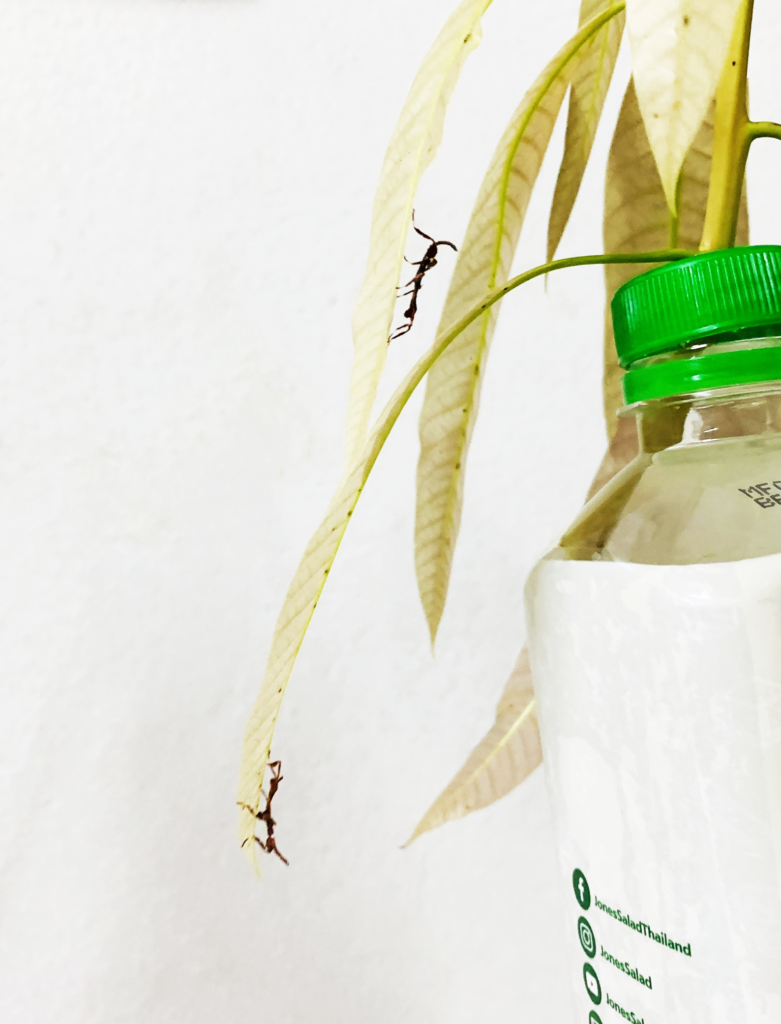
The light mango leaves have a yellowish-green pale color. The surface of the leaves is smooth and soft. We can find the light leaves on the top of branches.
ใบมะม่วงอ่อน มีสีเขียวซีดจางอมเหลือง พื้นผิวของใบมีลักษณะเรียบและอ่อน เราจะพบใบอ่อนได้บนยอดกิ่งของต้น
Light Guava Leaves (ใบฝรั่งอ่อน)
The light guava leaves are not able to determine from the color of leaves for 100%. In general, we determine by looking at the color of veins and branches that have to be light green.
ใบฝรั่งอ่อน สีของใบอาจไม่สามารถแยกออกได้ 100% โดยส่วนใหญ่เราจะแยกจากเส้นหลังใบ และกิ่งของใบ ทั้งกิ่งฝรั่งอ่อนและใบฝรั่งอ่อนจะเป็นสีเขียวอ่อน
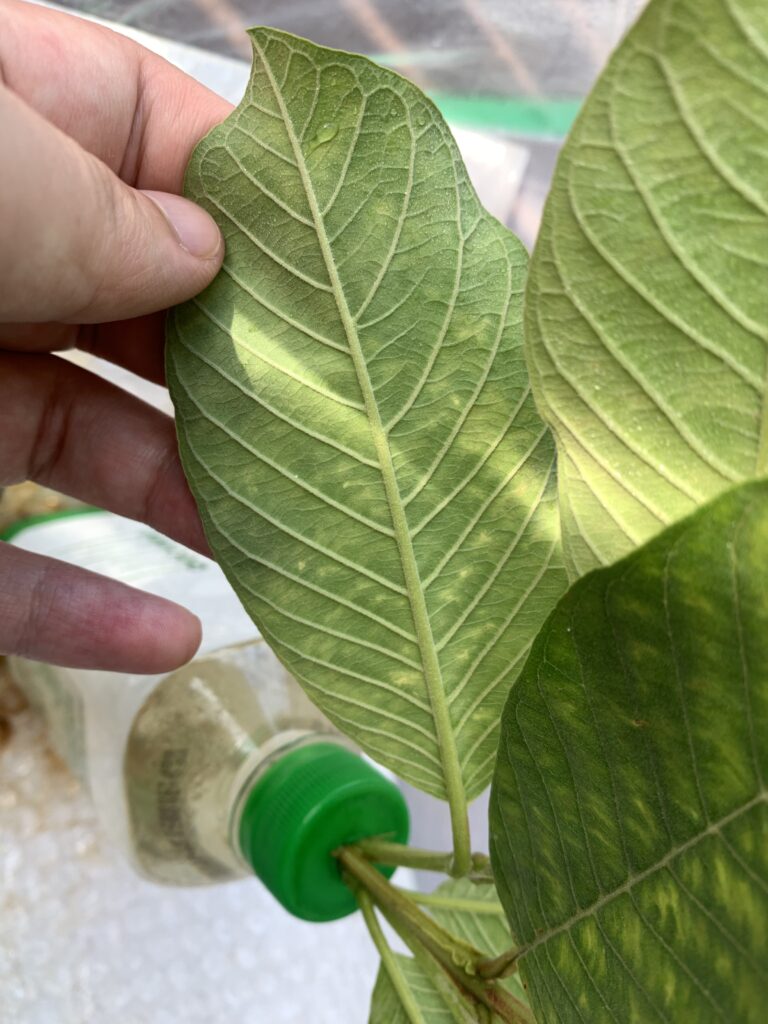
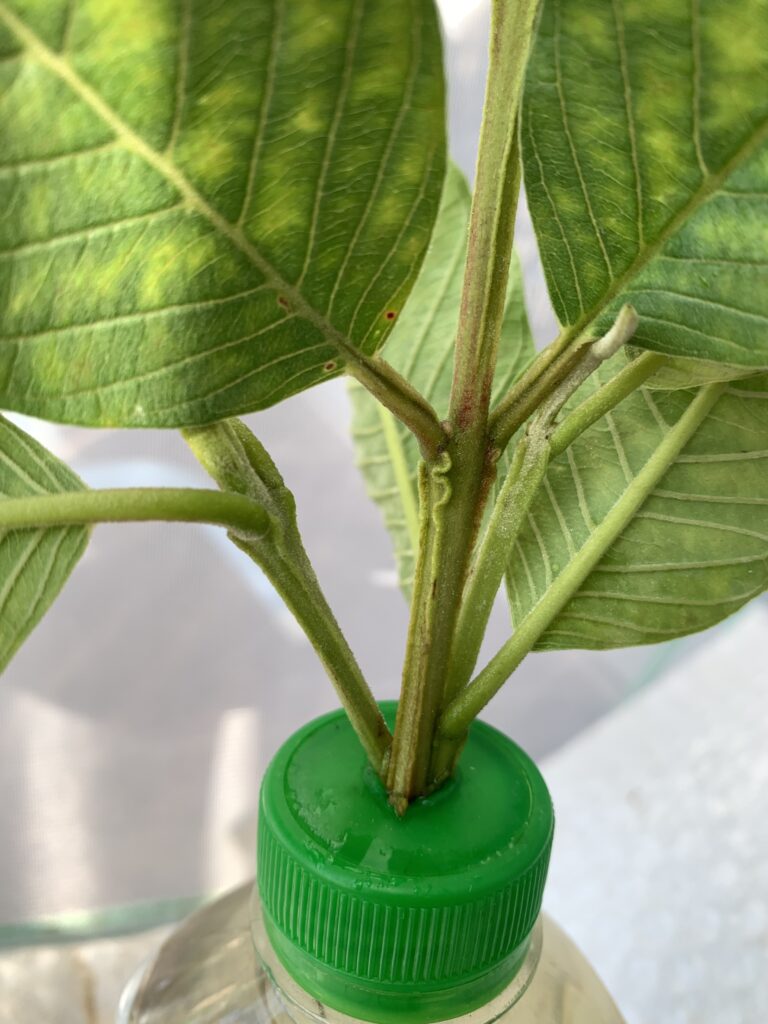
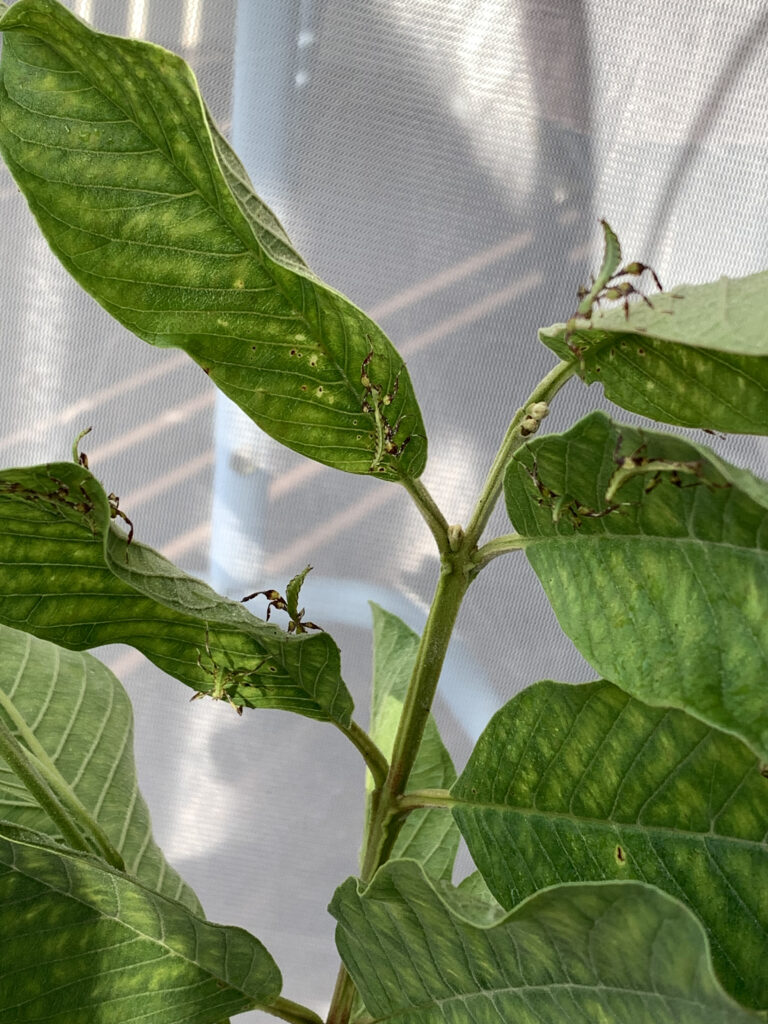
How Do We Know Their Nymphal Stages? | เราจะรู้ระยะตัวอ่อนได้อย่างไร
The nymphal stages of the leaf insect are determined by the length of the nymph. There is no official report or research of the length in each stage. But I try my best to measure the length in every stage with my vernier calipers. For the first instar (L1), the colored nymphs are red, and it turns to green or yellowish-green about 2 – 3 weeks.
ระยะตัวอ่อนของตั๊กแตนใบไม้ถูกจำแนกได้จากขนาดของตัวอ่อนในแต่ละระยะ ณ ตอนนี้ไม่มีงานวิจัยหรือรายงานเกี่ยวกับขนาดของทุกระยะของตั๊กแตนใบไม้ แต่ผมก็พยายามเต็มความสามารถในการวัดขนาดในทุก ๆ ระยะ ด้วยเวอร์เนียร์คาลิปเปอร์ สำหรับตัวอ่อนระยะที่ 1 (L1) สีของตัวอ่อนจะเป็นสีแดง และจะเปลี่ยนเป็นสีเขียว หรือสีเขียวอมเหลือง ประมาณ 2-3 สัปดาห์
Can I determine their gender on the nymphal stages? | ฉันสามารถแยกเพศได้ในระยะตัวอ่อนได้มั้ย
The answer is Yes, you can determine the gender at the third instar (L3). It is not hard to determine if you have a guide to determine them. In these pictures below they are my records. So, I disclaim that I am not a researcher or an expert on this species. But I try my best to record, and I will update my records every month.
คำตอบ คือ ใช่ เราสามารถจำแนกเพศได้ในระยะที่ 3 (L3) มันไม่ยากเลยที่จะแยกเพศหากคุณมีไกด์ที่จะช่วยแยกเพศพวกทัน ในภาพข้างใต้คือผลบันทึกของผม ซึ่งผมขอออกตัวก่อนว่าผมไม่ใช่นักวิจัย หรือผู้เชี่ยวชาญของสายพันธุ์สปีชี่ส์นี่ แต่ผมจะพยายามอย่างเต็มที่ในการบันทึกจดผล และอัปเดตผลบันทึกทุกเดือน
| Pictures | Nymphal stages | Length |
 | L1 | ~12.0 mm. |
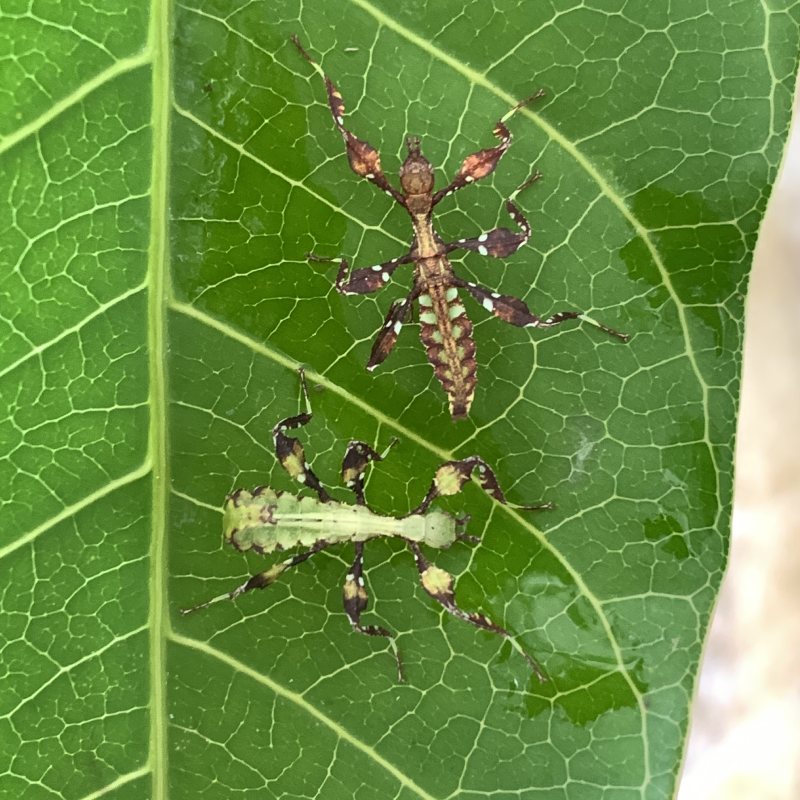 | L2 | ~12.0 mm. |
Female: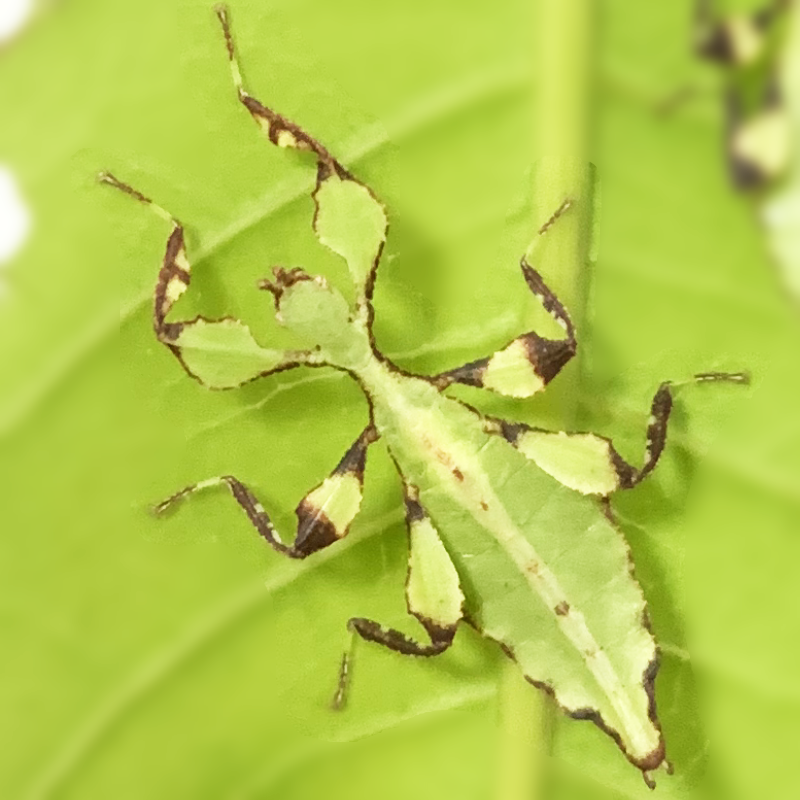 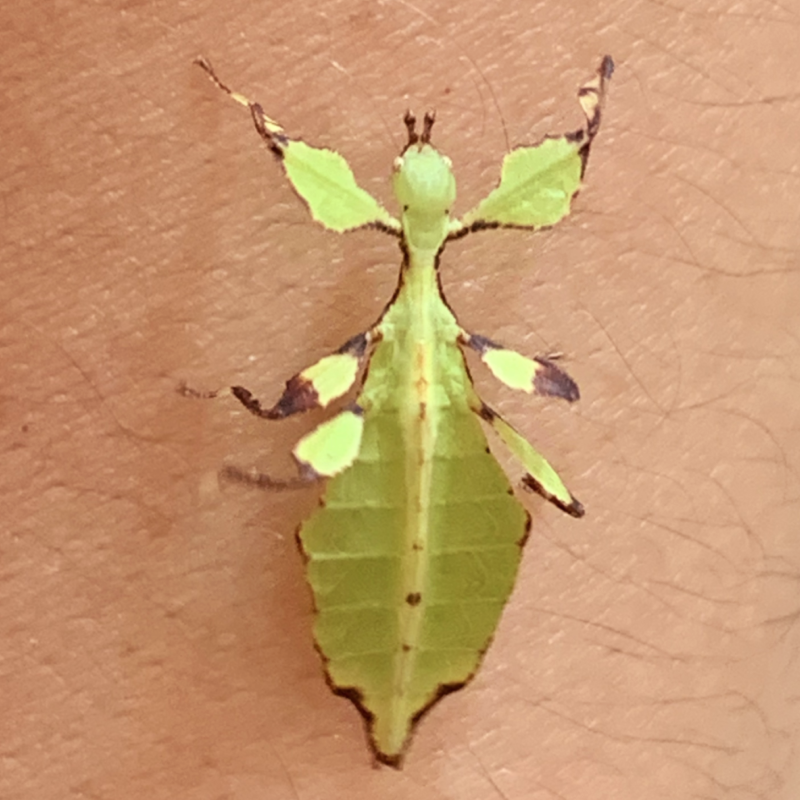 Male: 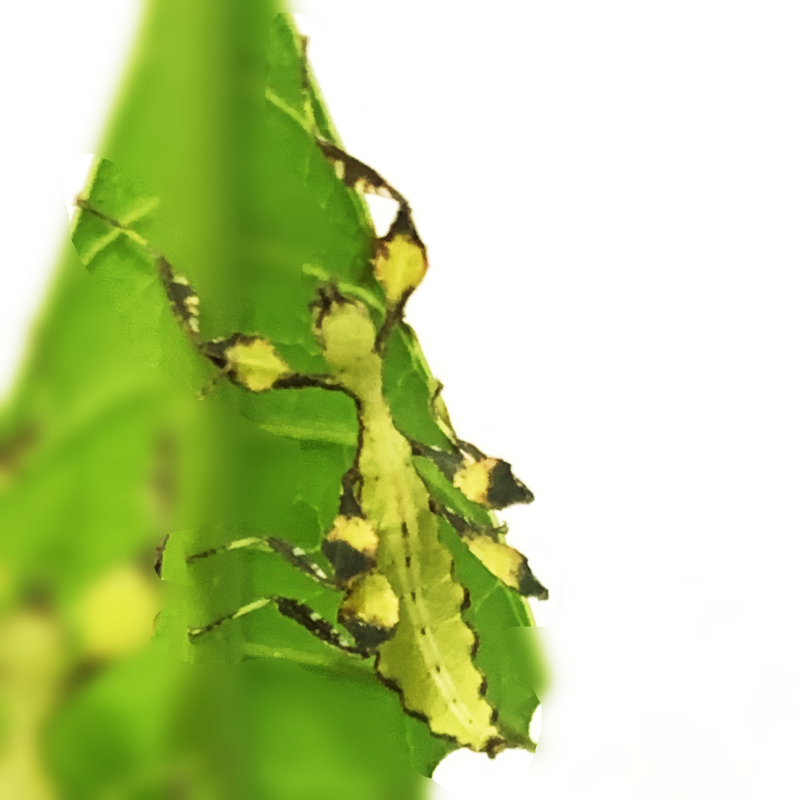 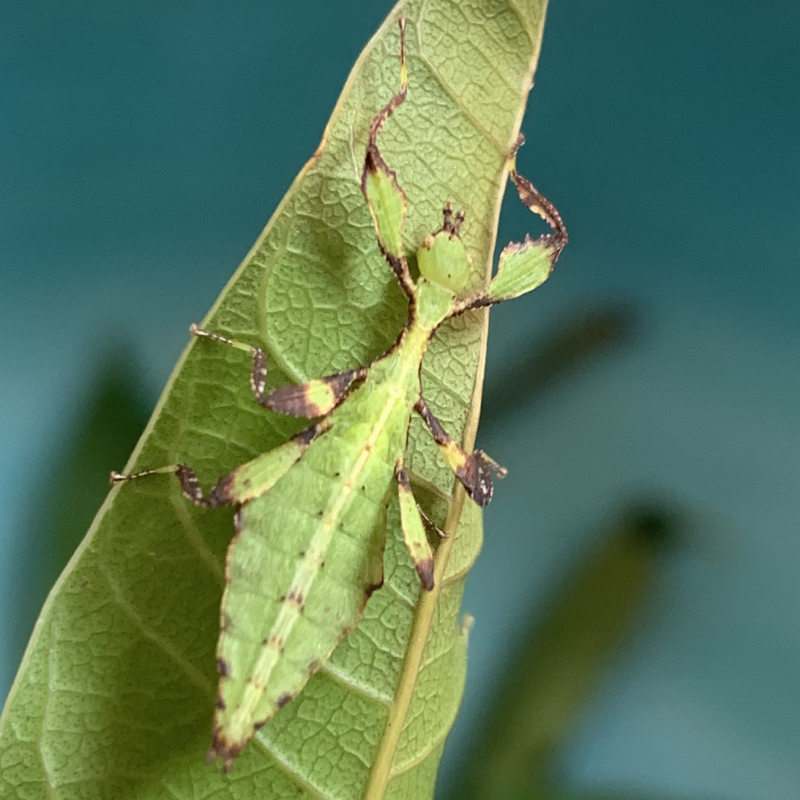 | L3 | Female: ~20.0 – 26.00 mm. Male: ~16.0 – 18.0 mm. |
Female: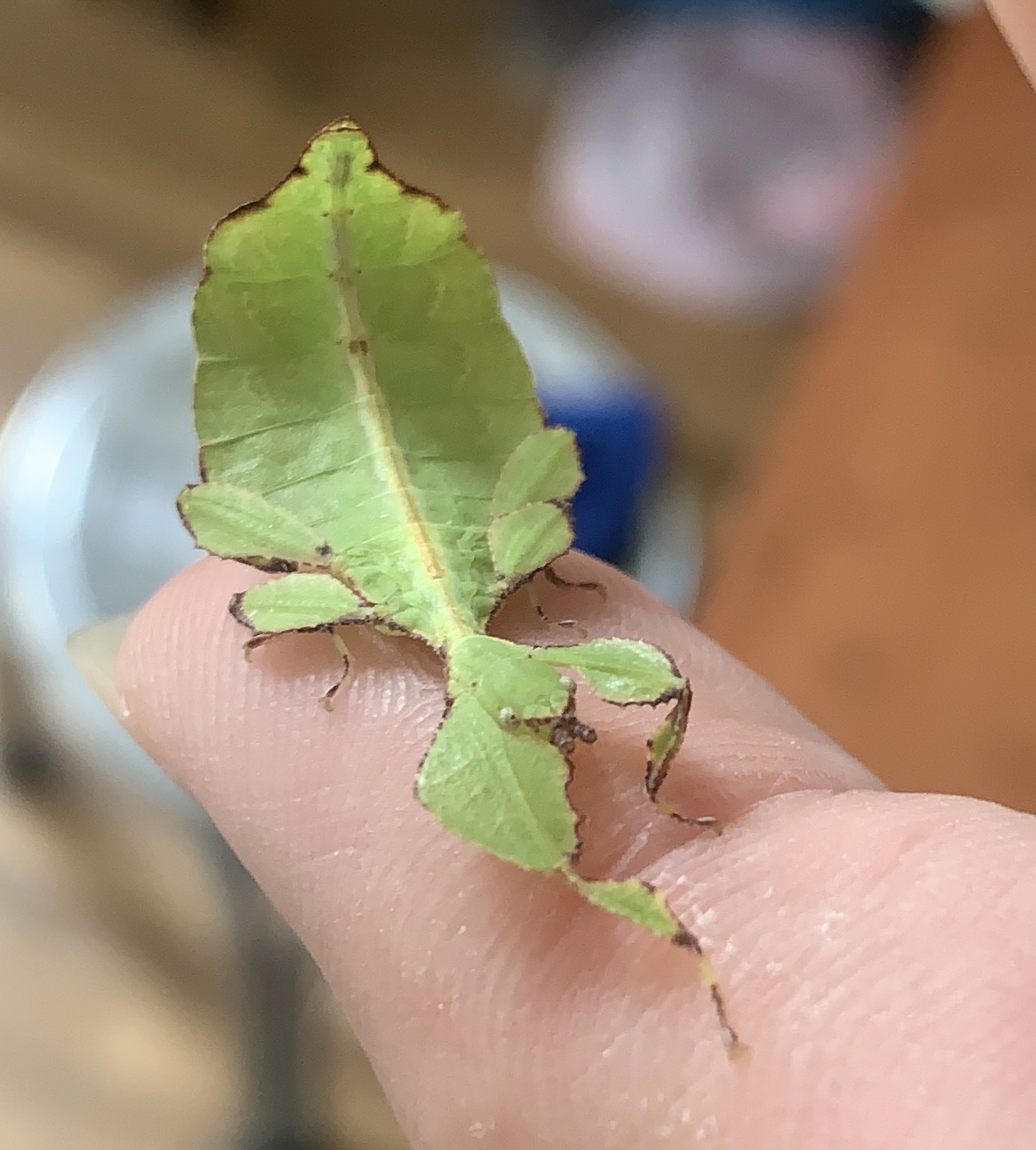 Male: 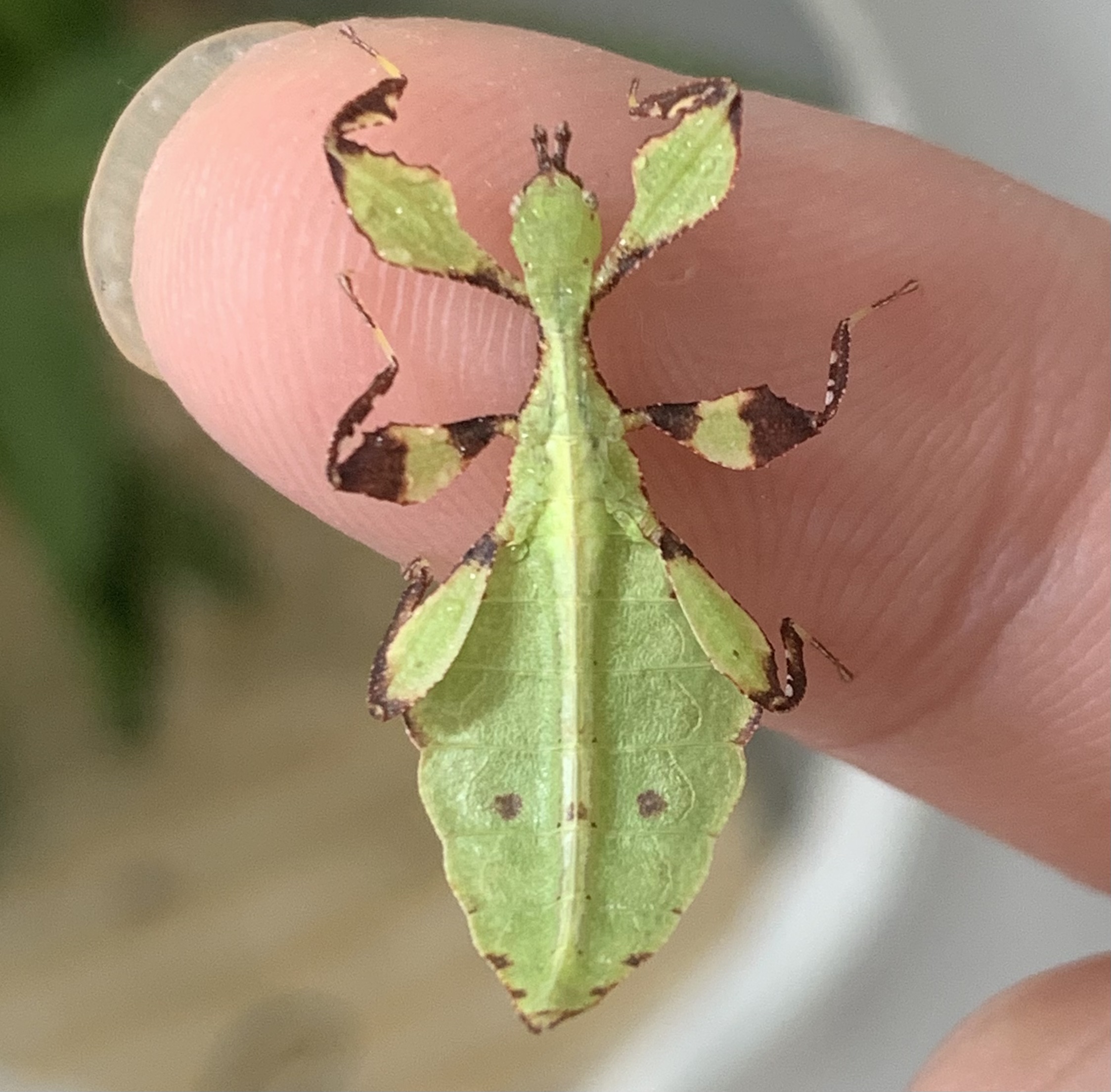 | L4 | Female: ~30.0 mm. Male: ~24.0 mm. |
Female: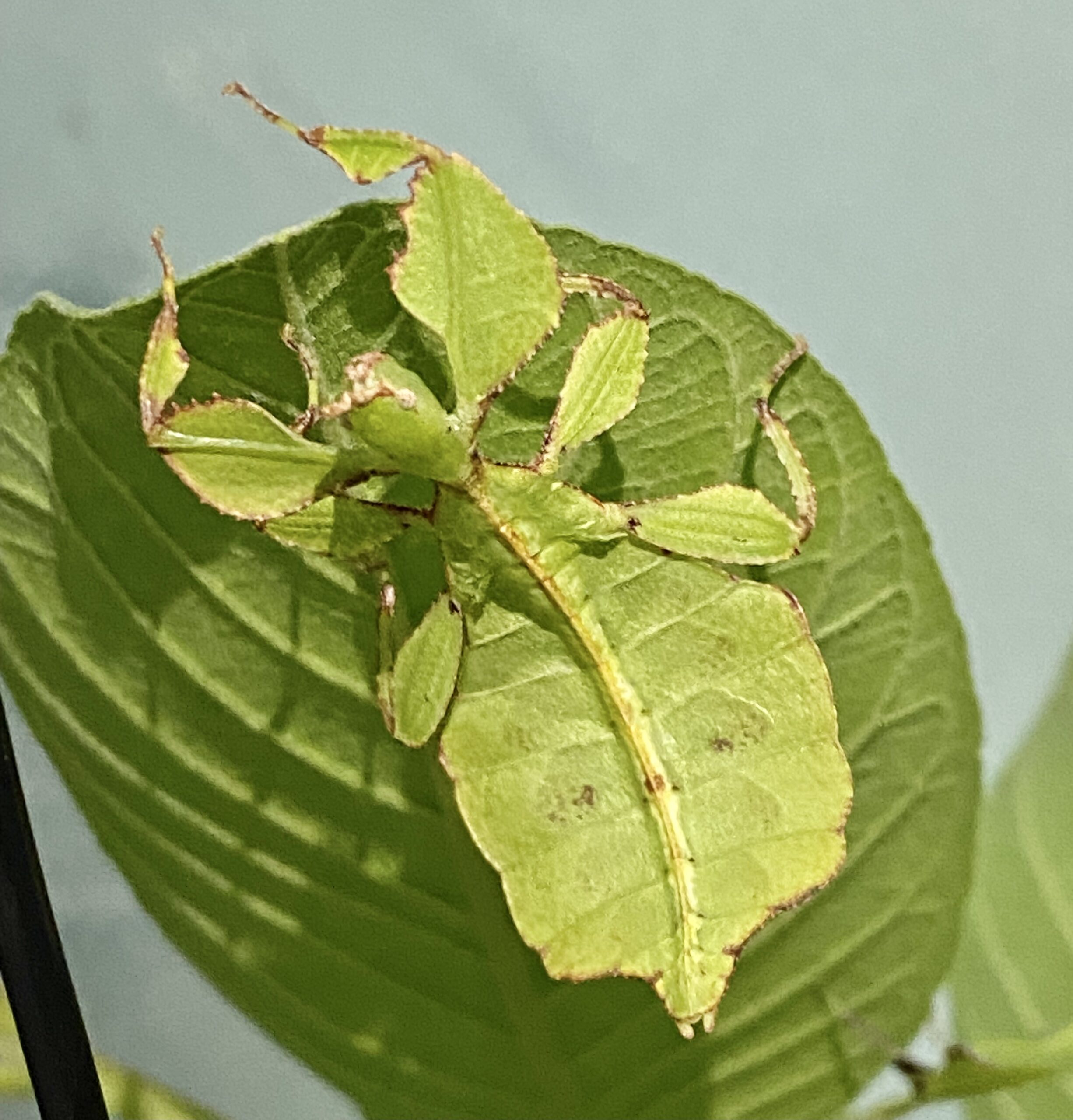 Male: 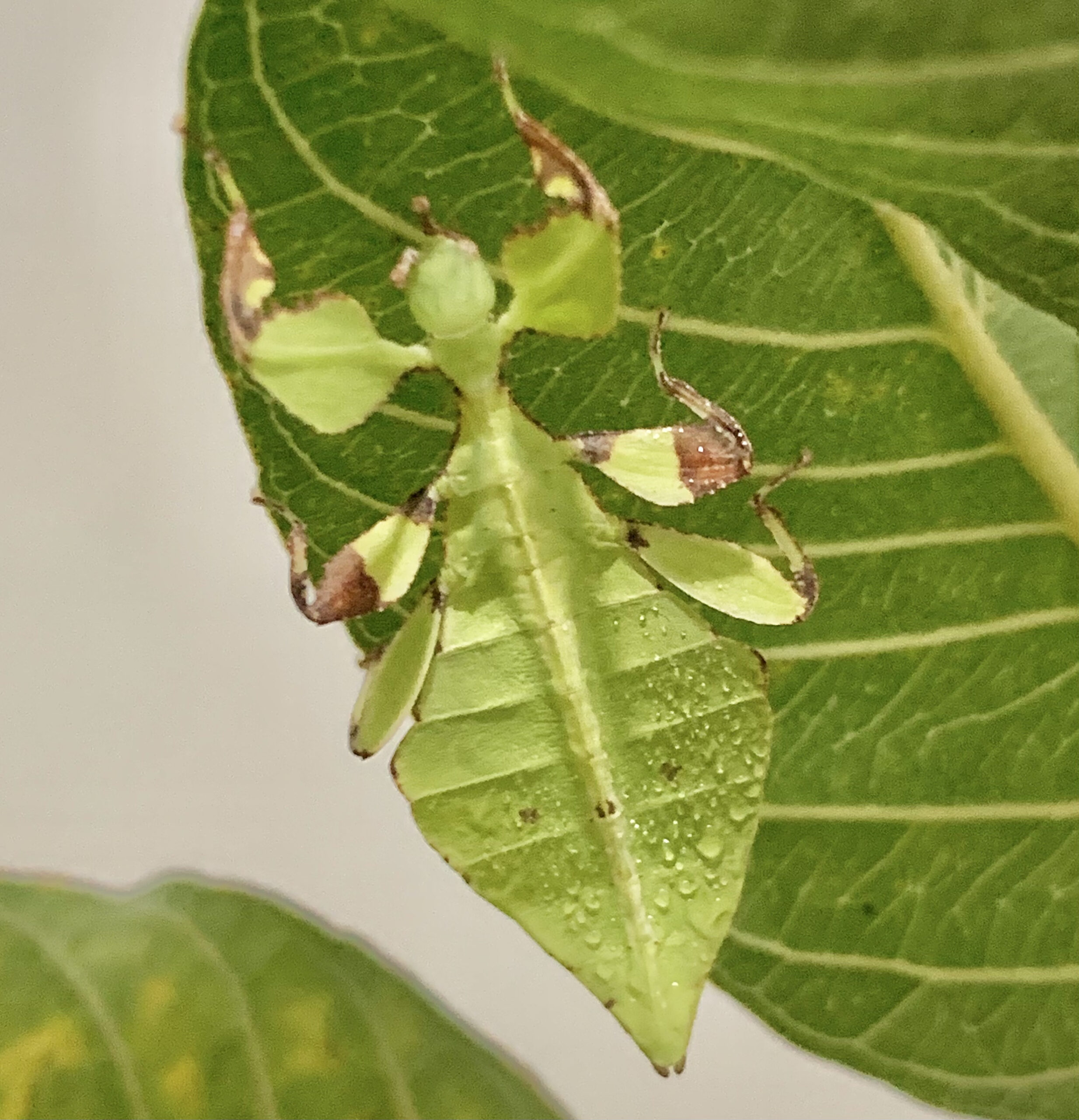 | L5 | Female: ~38.0 – 40.0 mm. Male: ~30.0 mm. |
Female: 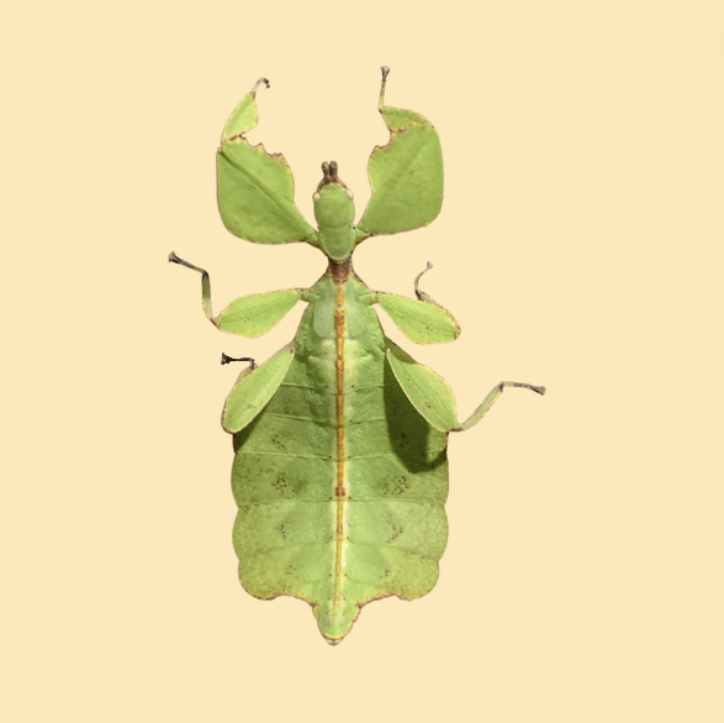 Male: | L6 | Female: ~49.5 mm. |
| Female: Male: | L7 | TBA |
If the shape of the third instar is still difficult to determine, you are able to determine at the fourth instar because it is very clear to define the gender.
หากรูปทรงของระยะ 3 ยังยากที่จะแยกเพศอยู่ คุณสามารถแยกได้ในระยะที่ 4 เพราะมันเริ่มเห็นรูปทรงชัดเจนขึ้นในการบ่งบอกเพศ และผมก็นำภาพวาดของรูปร่างตั๊กแตนใบไม้มาให้ดูกัน
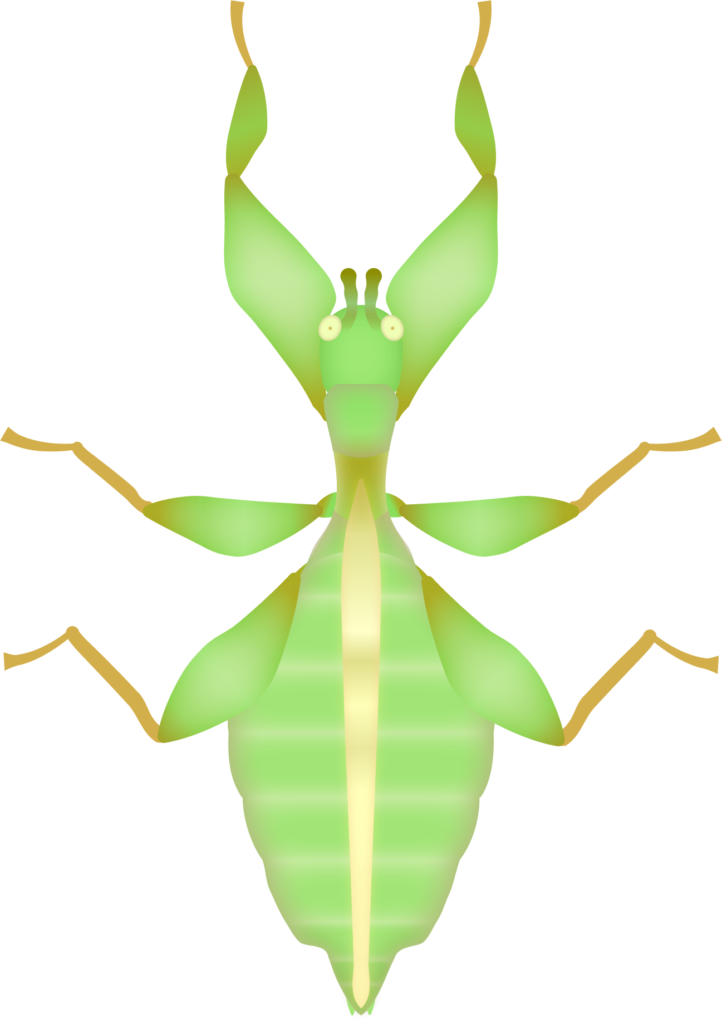
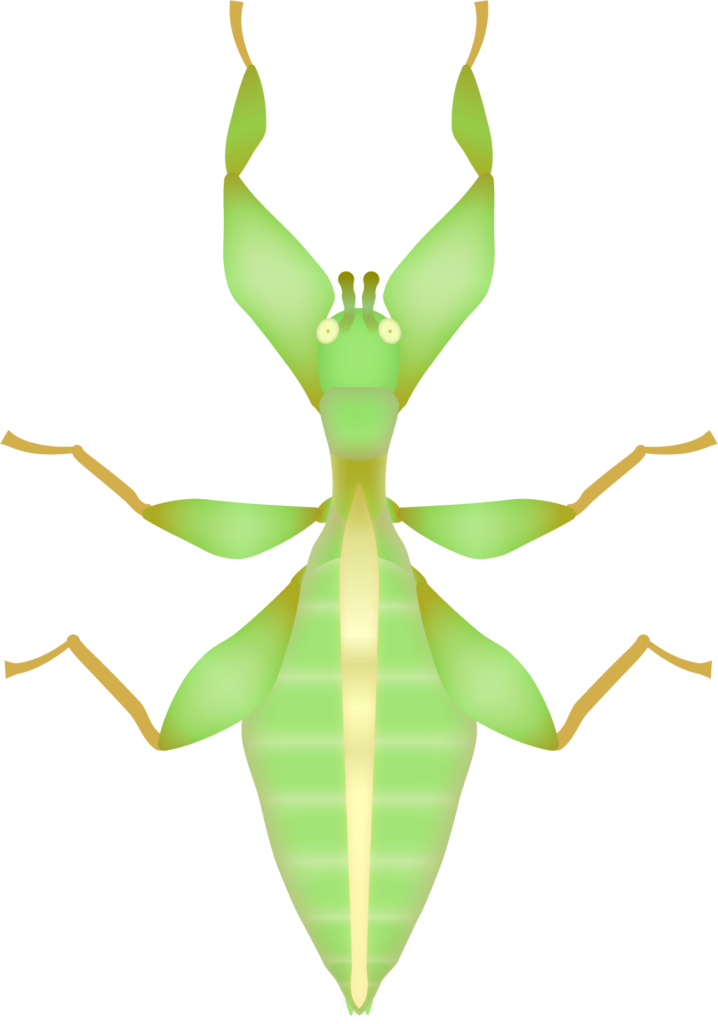
Citation & External Links | แหล่งอ้างอิงและข้อมูลอื่น
- M. Arai and M. Yago, “Curious oviposition behavior in phyllium westwoodii(phasmatodea: Phylliidae): Preliminary observations,” Journal of Insect Science, vol. 15, no. 1, p. 135, Sep. 2015.
- R. T. Cumming, S. Bank, J. Bresseel, Constant Jérôme, S. Le Tirant, Z. Dong, G. Sonet, and S. Bradler, “Cryptophyllium, the hidden leaf insects – descriptions of a new leaf insect genus and thirteen species from the former celebicum species group (Phasmatodea, Phylliidae),” ZooKeys, vol. 1018, pp. 1–179, Feb. 2021.
- https://commons.wikimedia.org/wiki/File:Phyliidae_eggs_of_5_species.jpg
- Phasmatodea.com. n.d. Cup-Incubation method | Phasmatodea. [online] Available at: <http://www.phasmatodea.com/cup-incubation> [Accessed 10 January 2022].

